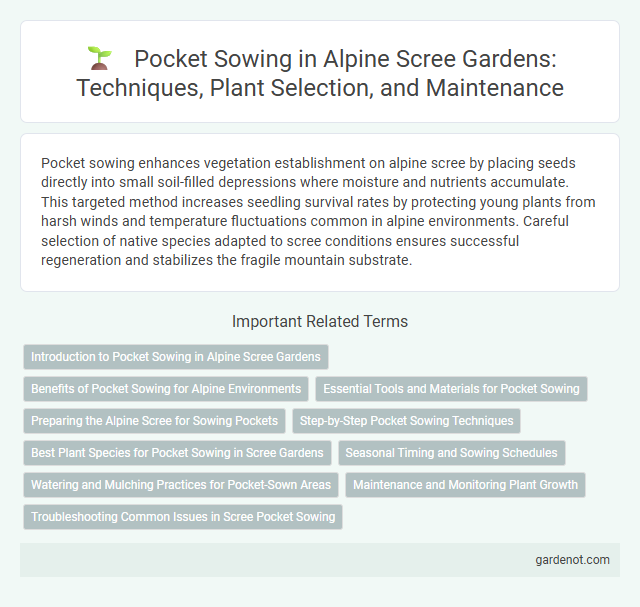Pocket sowing enhances vegetation establishment on alpine scree by placing seeds directly into small soil-filled depressions where moisture and nutrients accumulate. This targeted method increases seedling survival rates by protecting young plants from harsh winds and temperature fluctuations common in alpine environments. Careful selection of native species adapted to scree conditions ensures successful regeneration and stabilizes the fragile mountain substrate.
Introduction to Pocket Sowing in Alpine Scree Gardens
Pocket sowing in alpine scree gardens involves strategically placing seeds in small depressions or pockets within the rocky substrate to encourage germination and growth under challenging conditions. This technique mimics natural seed dispersal and enhances moisture retention and protection from environmental stressors, promoting successful establishment of hardy alpine plants. Using pocket sowing improves plant diversity and stability in scree habitats by supporting species adapted to nutrient-poor, well-drained soils.
Benefits of Pocket Sowing for Alpine Environments
Pocket sowing supports the restoration of alpine scree by enabling targeted seed placement in sheltered microhabitats, increasing seedling survival rates under harsh mountain conditions. It enhances germination by protecting seeds from wind erosion and extreme temperature fluctuations common in alpine zones. The technique promotes biodiversity by facilitating the establishment of native alpine plant species adapted to nutrient-poor, rocky substrates.
Essential Tools and Materials for Pocket Sowing
Essential tools and materials for pocket sowing in alpine scree include a trowel or small digging tool to create appropriate soil pockets, native seed mixes adapted to high altitudes, and a lightweight watering device for targeted moisture application. Using compost or organic matter helps improve soil structure within pockets, enhancing seed germination and root establishment. Protective measures like mesh coverings or biodegradable mats can shield seeds from harsh alpine winds and erosion.
Preparing the Alpine Scree for Sowing Pockets
Preparing the alpine scree for sowing pockets involves clearing debris and ensuring optimal soil drainage to mimic natural conditions. Select well-drained, rocky substrates with minimal organic matter to support seed implantation and germination. Creating shallow pockets by lightly loosening the substrate encourages seed contact with mineral soil, vital for seedling establishment in harsh alpine environments.
Step-by-Step Pocket Sowing Techniques
Step-by-step pocket sowing techniques involve carefully selecting suitable scree patches on alpine slopes to maximize seed germination and plant establishment. Seeds are precisely placed into small, shallow holes or pockets created by gently removing gravel or scree material, ensuring direct soil contact and optimal moisture retention for alpine species. This method enhances seed survival in harsh alpine environments by protecting seeds from wind erosion and temperature fluctuations typical of rugged scree habitats.
Best Plant Species for Pocket Sowing in Scree Gardens
Sedum species, such as Sedum acre and Sedum album, are ideal for pocket sowing in alpine scree gardens due to their drought tolerance and shallow root systems. Saxifraga species, including Saxifraga granulata and Saxifraga oppositifolia, thrive in rocky crevices and provide vibrant blooms while stabilizing loose scree substrates. Other suitable species include Draba and Silene, which quickly establish in nutrient-poor scree soils and enhance biodiversity with their compact growth habits.
Seasonal Timing and Sowing Schedules
Pocket sowing in alpine scree requires precise seasonal timing, typically conducted in early spring or late autumn to align with natural germination cycles and temperature fluctuations. The sowing schedule should prioritize periods just before snowmelt or after frost, ensuring seeds benefit from moist, well-drained conditions crucial for seedling establishment. Adhering to these seasonal windows maximizes germination rates and supports the successful colonization of alpine scree environments.
Watering and Mulching Practices for Pocket-Sown Areas
Watering pocket-sown alpine scree areas requires precise moisture control to prevent soil erosion and support seed germination, ideally using gentle, low-pressure methods that mimic natural rainfall patterns. Mulching with inorganic materials like gravel or small stones enhances moisture retention, stabilizes temperature fluctuations, and suppresses weed growth, crucial for the delicate alpine ecosystem. Consistent monitoring ensures balance; overwatering or excessive mulch can disrupt root development and plant establishment.
Maintenance and Monitoring Plant Growth
Pocket sowing in alpine scree requires diligent maintenance to ensure seedling establishment in harsh, rocky environments characterized by poor soil and rapid drainage. Regular monitoring of plant growth involves assessing germination rates, soil moisture levels, and microhabitat conditions to adapt irrigation and erosion control measures effectively. Implementing targeted interventions supports vegetation stabilization and enhances biodiversity in these fragile alpine ecosystems.
Troubleshooting Common Issues in Scree Pocket Sowing
Scree pocket sowing often faces challenges such as seed washout due to heavy rainfall or inadequate soil contact, which can be mitigated by using mesh covers or stabilizing materials. Poor germination rates frequently stem from unsuitable seed depth or moisture levels, requiring precise calibration of sowing techniques and consistent monitoring of microclimate conditions. Addressing pest predation involves using protective barriers or natural repellents to safeguard young seedlings in fragile alpine scree environments.
Pocket sowing Infographic

 gardenot.com
gardenot.com